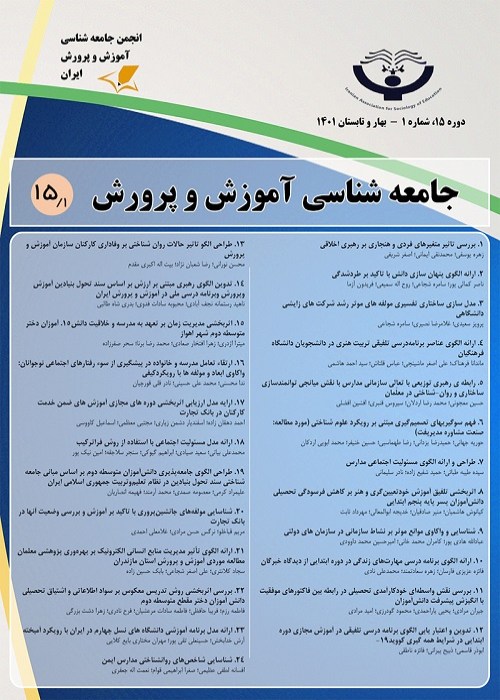Designing an Organizational Friction Pattern in Education of Golestan Province with Approach of Grounded Theory
Author(s):
Article Type:
Research/Original Article (دارای رتبه معتبر)
Abstract:
Purpose
The aim of this research was designing an organizational friction pattern in education of Golestan province with approach of grounded theory. Methodology
This study in terms of purpose was applied and in terms of implementation method was qualitative from type of exploratory and with approach of grounded theory. The research population was experts in the fields of educational management, human resource management and organizational behavior of education in Golestan province in 2020 academic year. The sample size based on the principle of theoretical saturation was estimated 20 people who were selected according to the inclusion criteria by purposive and snowball sampling methods. Data were collected through semi-structured interviews and analyzed by open, axial and selective coding methods based on Strauss and Corbin (1998) theory in NVivo software. Findings
The results showed that organizational friction in education had 87 concepts and 20 sub-categories in 6 main categories including organization weak strategies (causal conditions), organizational friction (axial phenomena), mental pressure in the workplace (interventionist conditions), internal organizational factors (contextual conditions), organizational anti-citizenship behaviors (actions) and organizational laziness (consequences). The organization weak strategies as causal conditions were included defective organizational structure, weakness in human resource management and weakness in strategic management, organizational friction as axial phenomena were included working indifference, working wasting time, lack of sense of responsibility, functional stupidity and heterogeneity of workforce management, mental pressure in the workplace as interventionist conditions were included concentration of control and power, nervous pressure in the workplace and distrust in the organization, internal organizational factors as contextual conditions were included weakness in performance evaluation, inefficiency of the administrative system, inattention to staff performance and inequality of financial and material, organizational anti-citizenship behaviors as actions were included anti-value behaviors and politicization and organizational laziness as consequences were included reduced organizational productivity, inefficient management of the organization and tendency to leave the job. Finally, organizational friction pattern in education were designed. Conclusion
The organizational friction pattern of the present research can be used by professionals and planners of education as a suitable pattern to reduce organizational friction through the identified categories.Keywords:
Language:
Persian
Published:
JOURNAL OF SOCIOLOGY OF EDUCATION, Volume:7 Issue: 1, 2021
Pages:
266 to 276
magiran.com/p2306472
دانلود و مطالعه متن این مقاله با یکی از روشهای زیر امکان پذیر است:
اشتراک شخصی
با عضویت و پرداخت آنلاین حق اشتراک یکساله به مبلغ 1,390,000ريال میتوانید 70 عنوان مطلب دانلود کنید!
اشتراک سازمانی
به کتابخانه دانشگاه یا محل کار خود پیشنهاد کنید تا اشتراک سازمانی این پایگاه را برای دسترسی نامحدود همه کاربران به متن مطالب تهیه نمایند!
توجه!
- حق عضویت دریافتی صرف حمایت از نشریات عضو و نگهداری، تکمیل و توسعه مگیران میشود.
- پرداخت حق اشتراک و دانلود مقالات اجازه بازنشر آن در سایر رسانههای چاپی و دیجیتال را به کاربر نمیدهد.
In order to view content subscription is required
Personal subscription
Subscribe magiran.com for 70 € euros via PayPal and download 70 articles during a year.
Organization subscription
Please contact us to subscribe your university or library for unlimited access!



